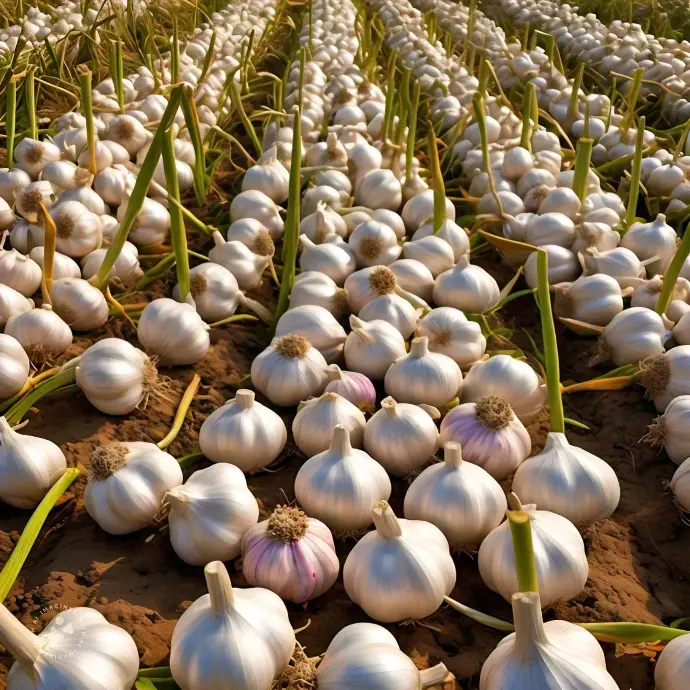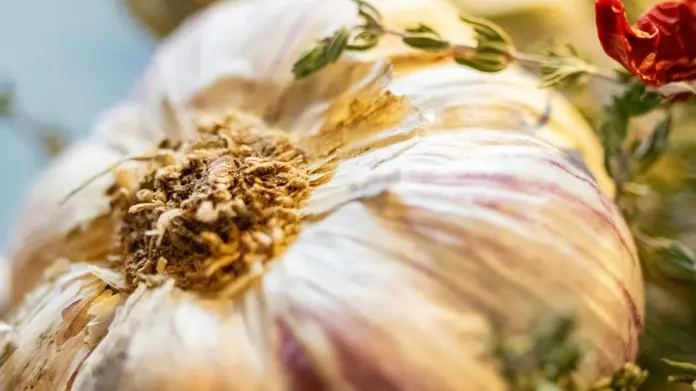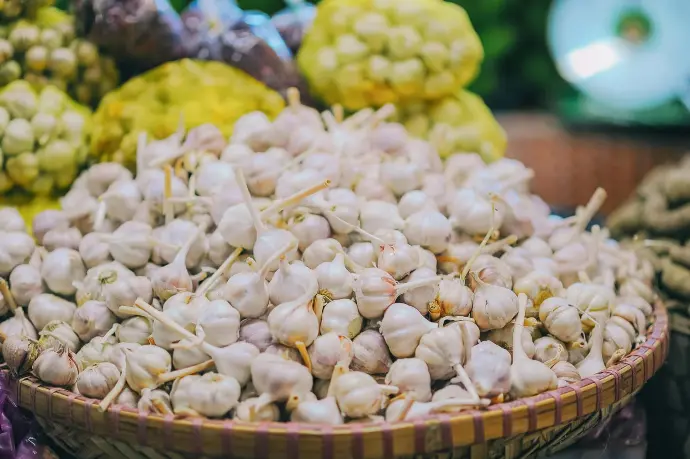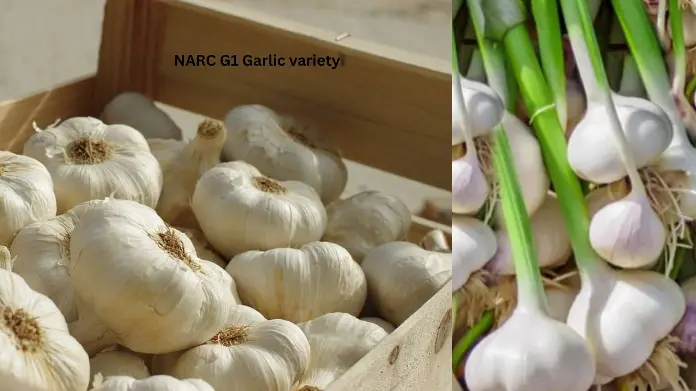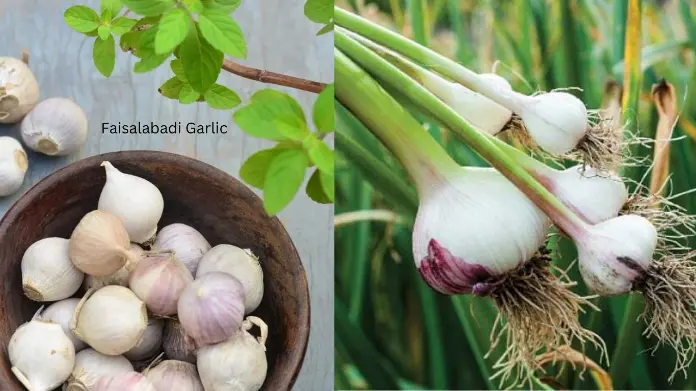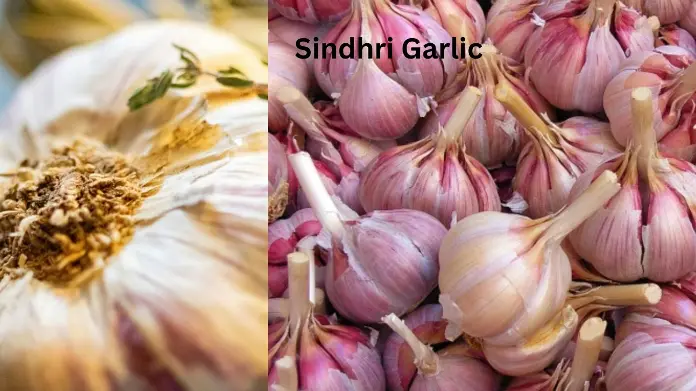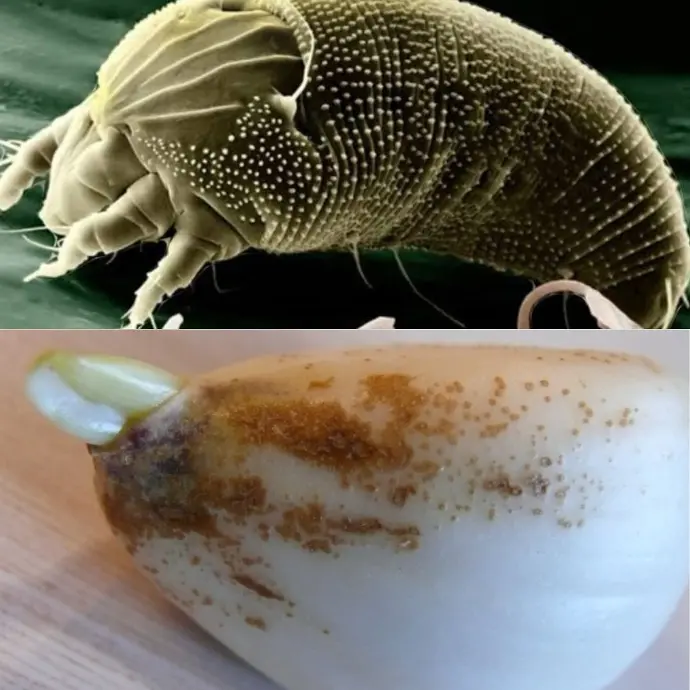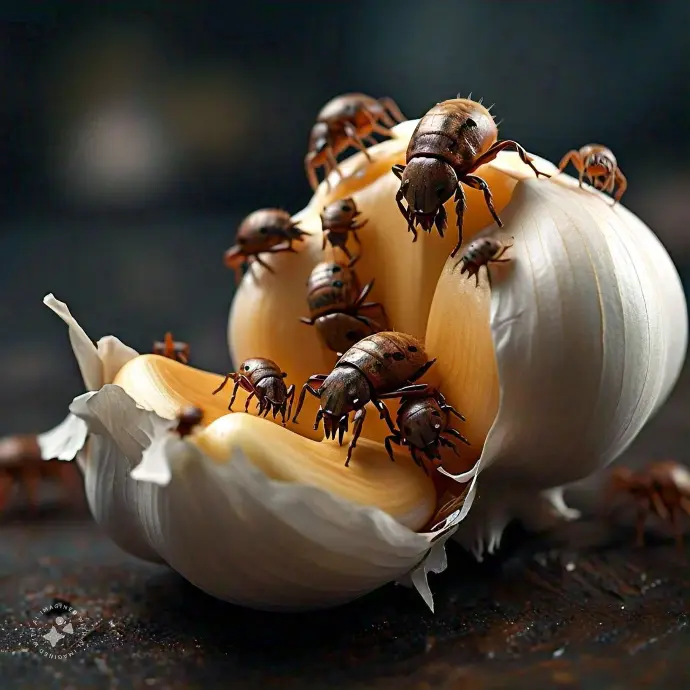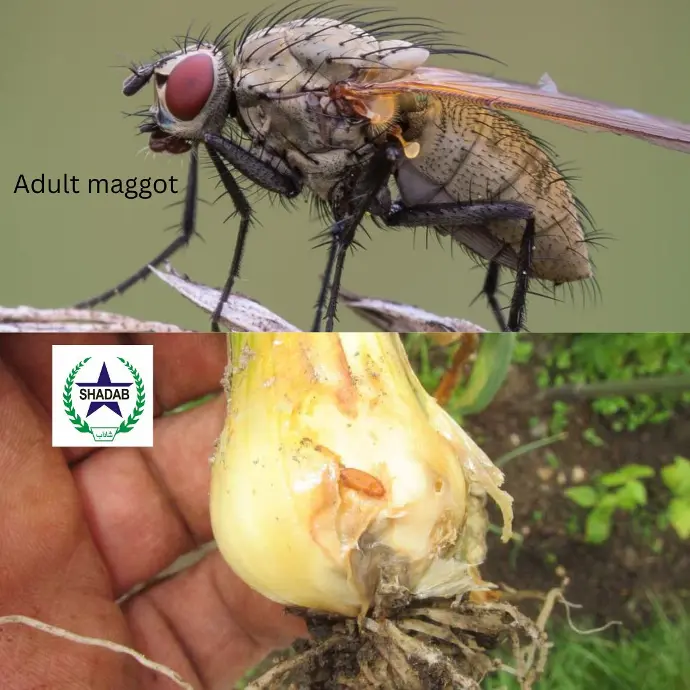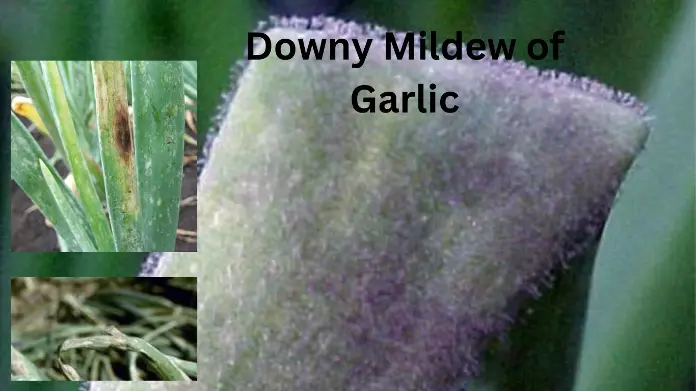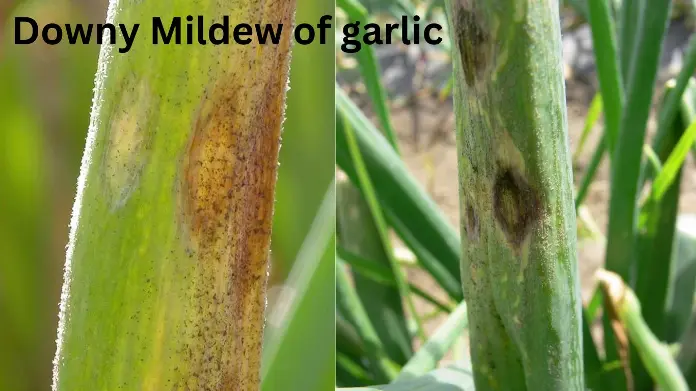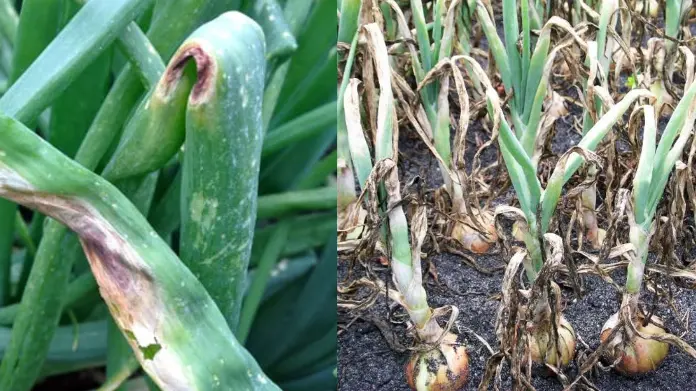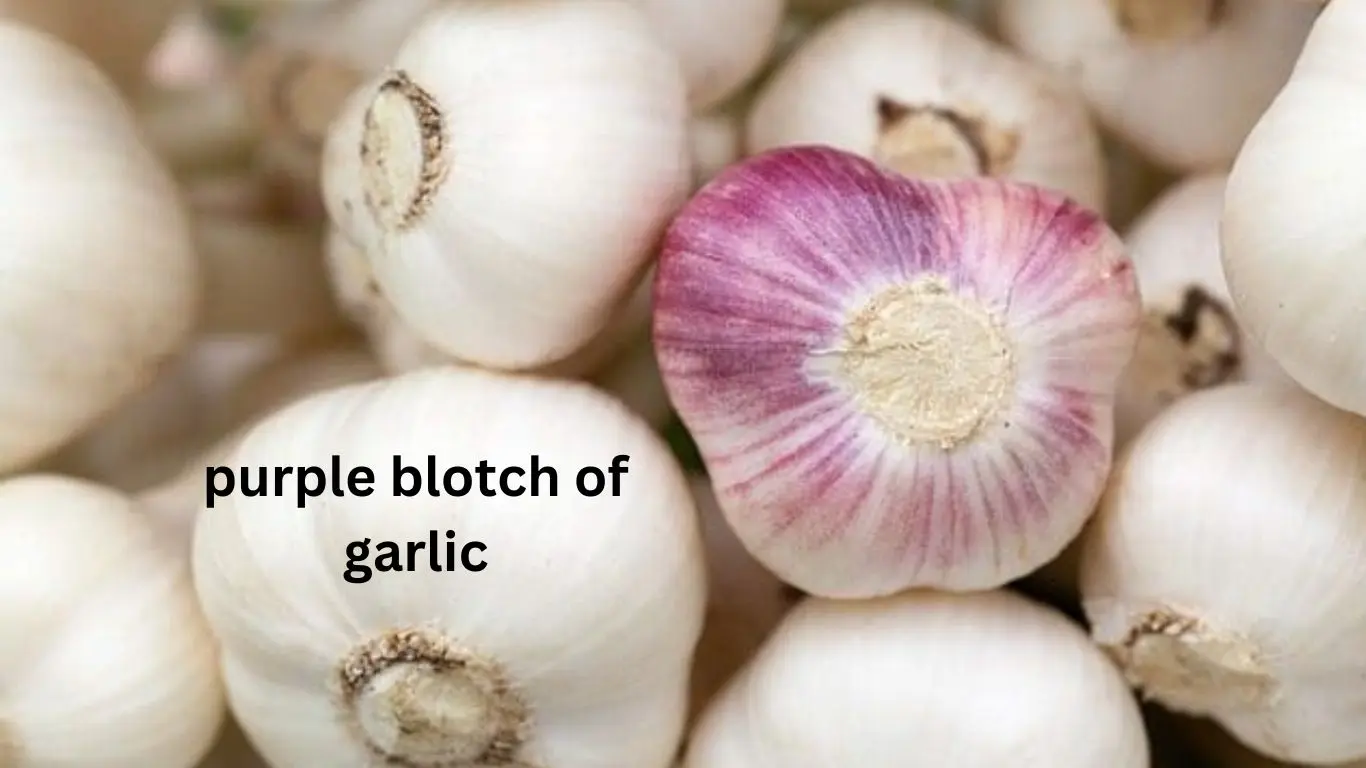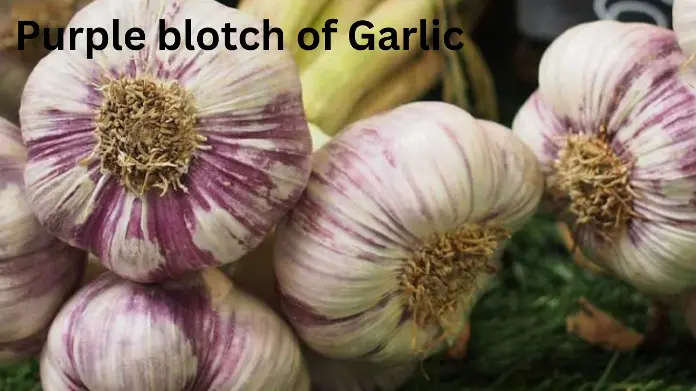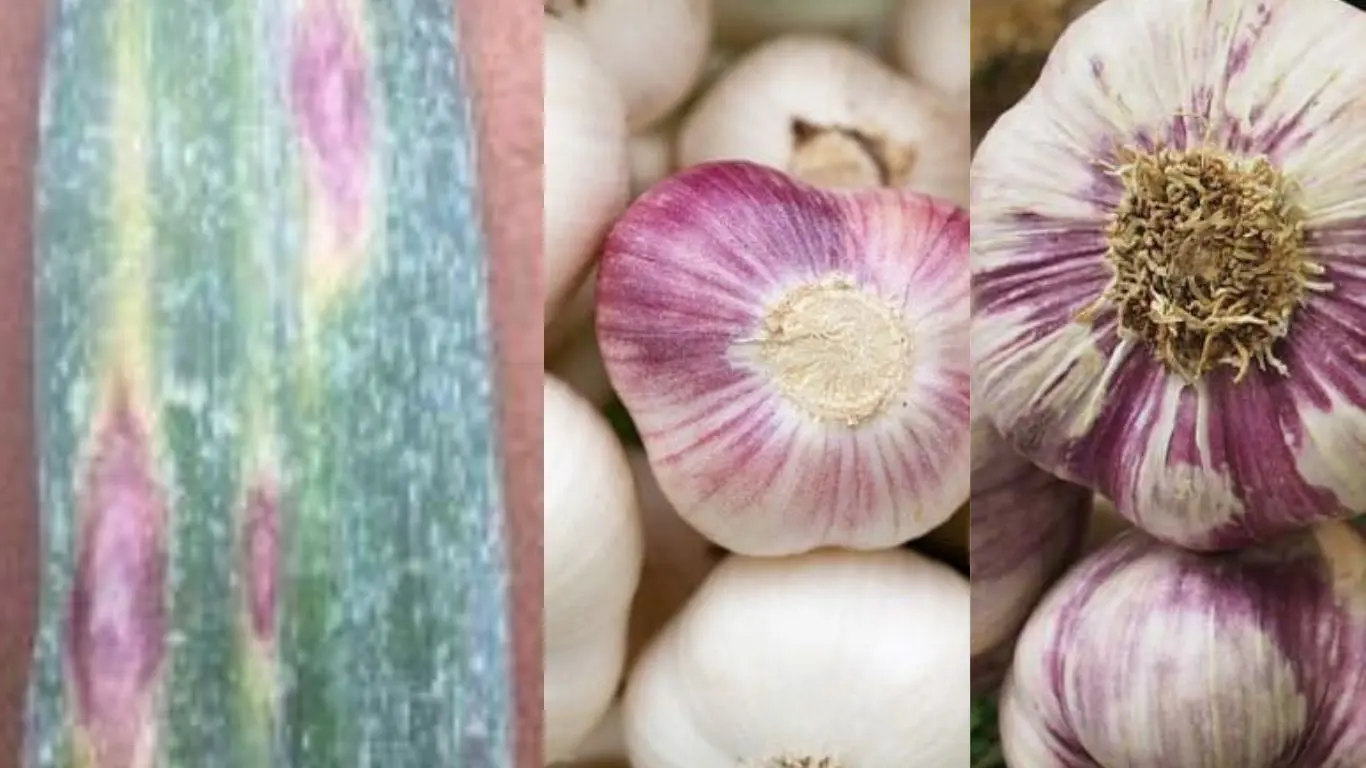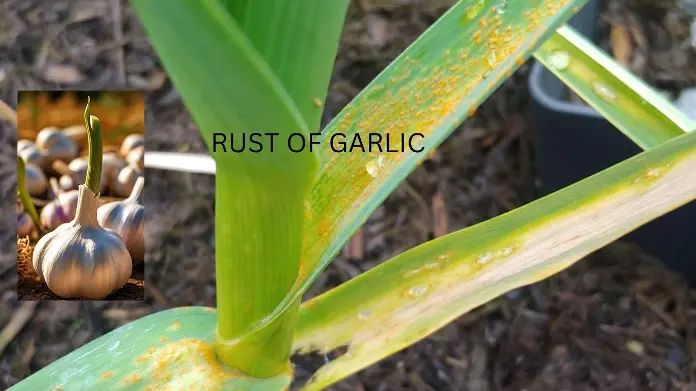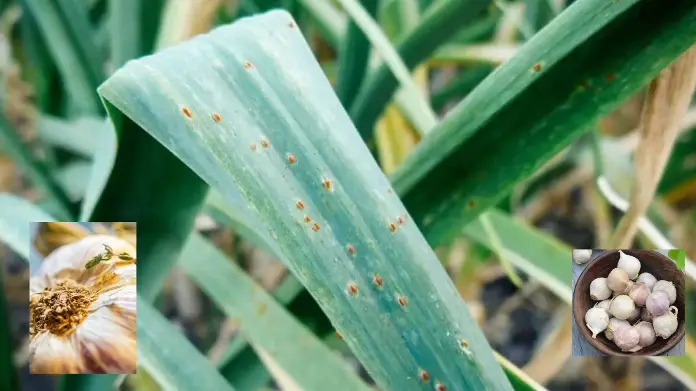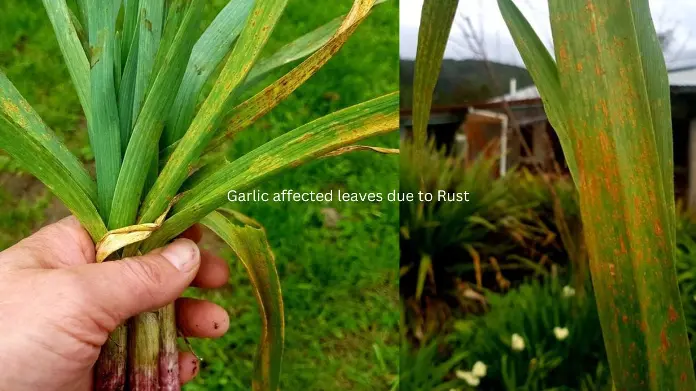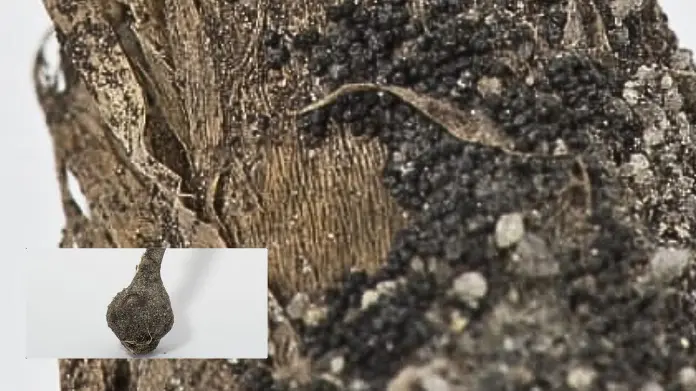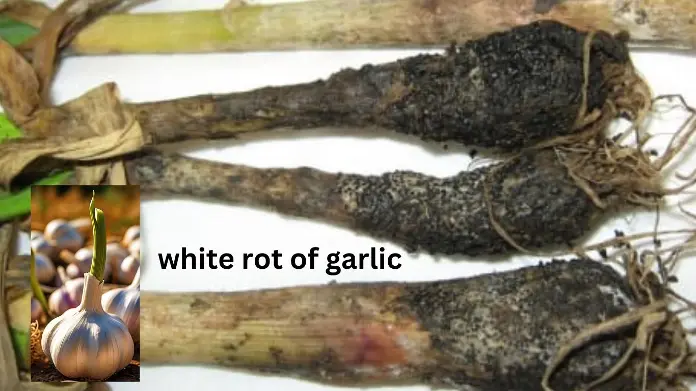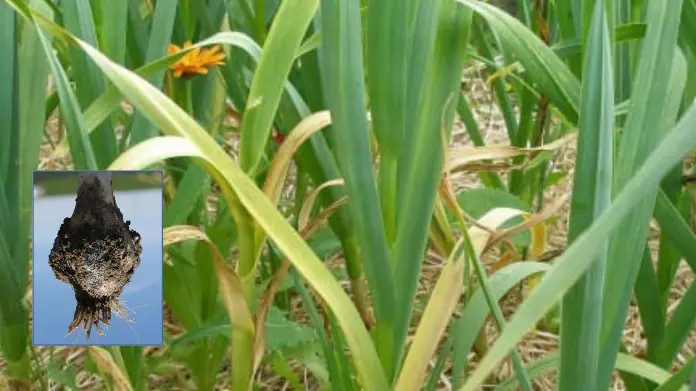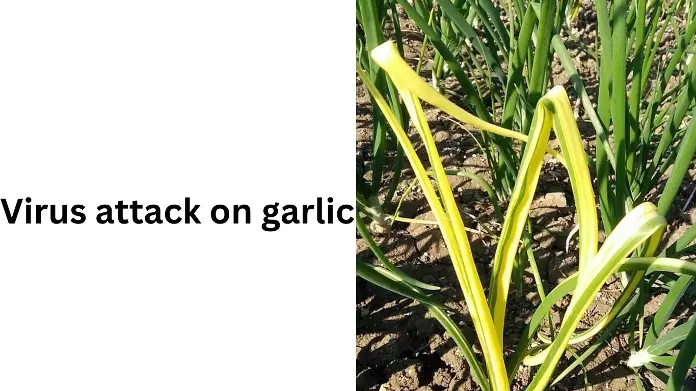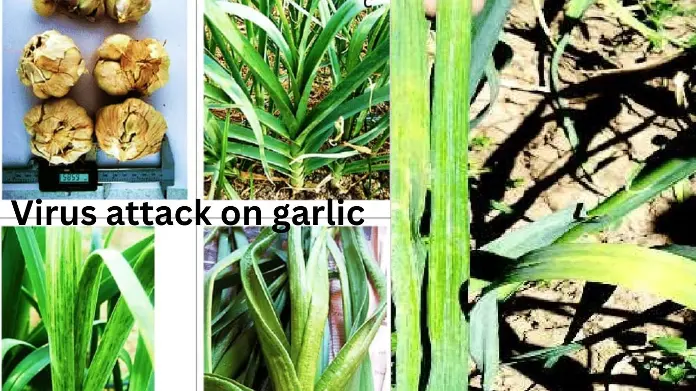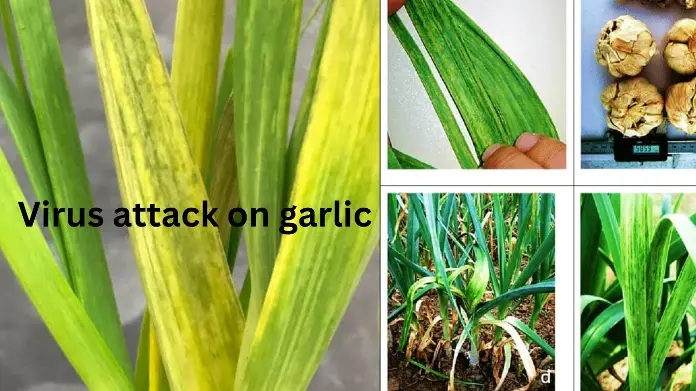AN INTRODUCTION TO GARLIC
Importance of Garlic in Pakistan
Pakistan's diverse climate and soil conditions create an optimal environment for garlic cultivation, which is both a widely used spice and a valued medicinal herb. The farming of garlic presents a promising opportunity for agricultural producers, offering the potential for substantial income and contributing positively to the country's agricultural sector. This guide aims to equip Pakistani farmers with essential knowledge and practical tips necessary for the successful cultivation of garlic.
پاکستان کی متنوع آب و ہوا اور مٹی کے حالات لہسن کی کاشت کے لیے ایک بہترین ماحول پیدا کرتے ہیں، جو کہ ایک وسیع پیمانے پر استعمال ہونے والا مسالا اور ایک قابل قدر دواؤں کی جڑی بوٹی ہے۔ لہسن کی کاشت زرعی پروڈیوسروں کے لیے ایک امید افزا موقع پیش کرتی ہے، جو خاطر خواہ آمدنی کے امکانات پیش کرتی ہے اور ملک کے زرعی شعبے میں مثبت کردار ادا کرتی ہے۔ اس گائیڈ کا مقصد پاکستانی کسانوں کو لہسن کی کامیاب کاشت کے لیے ضروری معلومات اور عملی تجاویز سے آراستہ کرنا ہے۔
Garlic Varieties in Pakistan:
In Pakistan, several garlic varieties are predominantly cultivated, each thriving in specific regions. In the Northern Areas, Peshawari Garlic is noted for its large cloves and robust flavor, making it well-suited for colder climates. Chitral Garlic, recognized for its long shelf life and strong aroma, also exhibits resistance to various diseases, enhancing its appeal among growers.Moving to Central Punjab, Faisalabadi Garlic stands out with its large bulbs and white skin, offering significant yield potential. Multan Garlic, characterized by its sizable cloves and milder taste, is favored for local consumption. In the Sindh region, Sindhri Garlic features small bulbs with purple skin and a pronounced flavor, thriving in arid conditions, while Larkana Garlic is appreciated for its early maturation and high yield, making it ideal for commercial farming.Baluchistan is renowned for its distinct varieties of garlic. Chaman garlic is celebrated for its exceptional flavor and extended shelf life, thriving in the region's mountainous terrain. In contrast, Quetta garlic features a white skin and possesses a milder taste, making it particularly well-suited for cultivation at elevated altitudes.
پاکستان میں، لہسن کی کئی اقسام بنیادی طور پر کاشت کی جاتی ہیں، جن میں سے ہر ایک مخصوص علاقوں میں پروان چڑھتی ہے۔ شمالی علاقہ جات میں، پشاوری لہسن اپنے بڑے لونگ اور مضبوط ذائقے کے لیے مشہور ہے، جو اسے سرد موسم کے لیے موزوں بناتا ہے۔ چترال لہسن، جو کہ اپنی طویل شیلف لائف اور مضبوط مہک کے لیے پہچانا جاتا ہے، مختلف بیماریوں کے خلاف مزاحمت کا مظاہرہ بھی کرتا ہے، جس سے کاشتکاروں میں اس کی کشش میں اضافہ ہوتا ہے۔ وسطی پنجاب میں منتقل ہونے سے، فیصل آبادی لہسن اپنے بڑے بلب اور سفید جلد کے ساتھ نمایاں ہے، جو کہ نمایاں پیداوار کی صلاحیت پیش کرتا ہے۔ ملتان لہسن، جو اس کے بڑے لونگ اور ہلکے ذائقے کی وجہ سے ہے، مقامی کھپت کے لیے پسند کیا جاتا ہے۔ سندھ کے علاقے میں، سندھڑی لہسن میں جامنی رنگ کی جلد اور ایک واضح ذائقہ والے چھوٹے بلب ہوتے ہیں، جو بنجر حالات میں پروان چڑھتے ہیں، جب کہ لاڑکانہ لہسن کو اس کی جلد پختگی اور زیادہ پیداوار کے لیے سراہا جاتا ہے، جو اسے تجارتی کاشتکاری کے لیے مثالی بناتا ہے۔ بلوچستان اپنی مخصوص اقسام کے لیے مشہور ہے۔ لہسن کی. چمن لہسن کو اس کے غیر معمولی ذائقے اور وسیع شیلف لائف کے لیے منایا جاتا ہے، جو خطے کے پہاڑی علاقوں میں پھلتا پھولتا ہے۔ اس کے برعکس، کوئٹہ لہسن کی جلد سفید ہوتی ہے اور اس کا ذائقہ ہلکا ہوتا ہے، جس کی وجہ سے یہ خاص طور پر بلندی پر کاشت کے لیے موزوں ہے۔
Garlic Pest and Disease Management:
Garlic is vulnerable to various pests and diseases that can significantly impact its growth and yield. Among the pests that may affect garlic are thrips, whiteflies, aphids, and stem borers. Additionally, garlic can be afflicted by several diseases, including purple blotch, white rot, rust, and downy mildew. To mitigate crop losses effectively, the implementation of integrated pest and disease management (IPDM) strategies is essential. These practices are designed to address and manage these challenges comprehensively.
Crop rotation involves the practice of cultivating garlic in a different location each year, which aids in disrupting the cycles of diseases. Selecting garlic varieties that exhibit resistance to common pests and diseases is also advisable. It is essential to maintain cleanliness in the field by clearing away plant debris and weeds following the harvest. The introduction of natural predators, such as ladybugs and lacewings, can serve as an effective biological control method against pests. Furthermore, the application of pesticides should be carried out judiciously, ensuring they are used only when absolutely necessary and in accordance with the recommended dosages.
لہسن مختلف کیڑوں اور بیماریوں کا شکار ہے جو اس کی نشوونما اور پیداوار کو نمایاں طور پر متاثر کر سکتے ہیں۔ لہسن کو متاثر کرنے والے کیڑوں میں تھرپس، سفید مکھیاں، افڈس، اور تنے کی چھید شامل ہیں۔ مزید برآں، لہسن کئی بیماریوں کا شکار ہو سکتا ہے، بشمول جامنی رنگ کے دھبے، سفید سڑ، زنگ اور نیچے کی پھپھوندی۔ فصلوں کے نقصانات کو مؤثر طریقے سے کم کرنے کے لیے، مربوط کیڑوں اور بیماریوں کے انتظام (IPDM) کی حکمت عملیوں کا نفاذ ضروری ہے۔ یہ طرز عمل ان چیلنجوں کو جامع طریقے سے حل کرنے اور ان سے نمٹنے کے لیے بنائے گئے ہیں۔فصل کی گردش میں ہر سال لہسن کو مختلف جگہوں پر کاشت کرنے کی مشق شامل ہوتی ہے، جو بیماریوں کے چکر میں خلل ڈالنے میں مدد کرتا ہے۔ لہسن کی ان اقسام کا انتخاب کرنا بھی مناسب ہے جو عام کیڑوں اور بیماریوں کے خلاف مزاحمت کا مظاہرہ کریں۔ فصل کی کٹائی کے بعد پودوں کے ملبے اور جڑی بوٹیوں کو صاف کرکے کھیت میں صفائی برقرار رکھنا ضروری ہے۔ قدرتی شکاریوں کا تعارف، جیسے لیڈی بگ اور لیس وِنگز، کیڑوں کے خلاف ایک مؤثر حیاتیاتی کنٹرول کے طور پر کام کر سکتے ہیں۔ مزید برآں، کیڑے مار ادویات کا استعمال درست طریقے سے کیا جانا چاہیے، اس بات کو یقینی بناتے ہوئے کہ ان کا استعمال صرف اس وقت کیا جائے جب بالکل ضروری ہو اور تجویز کردہ خوراکوں کے مطابق ہو۔
Garlic Cultivation Method:
The cultivation of garlic necessitates a well-rounded provision of nutrients to ensure its growth and productivity. Prior to planting, it is essential to perform soil tests to assess nutrient concentrations and to establish appropriate fertilizer application rates. Enriching the soil with well-decomposed organic manure or compost is recommended to enhance its organic matter content, thereby supporting healthier plant development.The application of nitrogen and phosphorus fertilizers should be guided by the results of the soil tests and the specific growth stages of the garlic plants. Additionally, irrigation practices must be carefully managed; garlic thrives with consistent, yet moderate, watering. It is advisable to implement deep and infrequent irrigation to foster robust root growth, which is crucial for the overall health of the plants.
لہسن کی کاشت کو اس کی نشوونما اور پیداواری صلاحیت کو یقینی بنانے کے لیے غذائی اجزاء کی اچھی طرح سے فراہمی کی ضرورت ہوتی ہے۔ پودے لگانے سے پہلے، ضروری ہے کہ مٹی کے ٹیسٹ کروائے جائیں تاکہ غذائی اجزاء کی تعداد کا اندازہ لگایا جا سکے اور کھاد کے استعمال کی مناسب شرحوں کو قائم کیا جا سکے۔ اچھی طرح سے گلنے والی نامیاتی کھاد یا کھاد کے ساتھ مٹی کو افزودہ کرنے کی سفارش کی جاتی ہے تاکہ اس کے نامیاتی مادے کے مواد کو بڑھایا جاسکے، اس طرح پودوں کی صحت مند نشوونما میں مدد ملتی ہے۔ نائٹروجن اور فاسفورس کھادوں کے استعمال کو مٹی کے ٹیسٹ کے نتائج اور مخصوص نشوونما کے مراحل سے رہنمائی حاصل کرنی چاہیے۔ لہسن کے پودے. اس کے علاوہ، آبپاشی کے طریقوں کو احتیاط سے منظم کیا جانا چاہئے؛ لہسن مسلسل، ابھی تک اعتدال پسند، پانی کے ساتھ پھلتا پھولتا ہے۔ جڑوں کی مضبوط نشوونما کو فروغ دینے کے لیے گہری اور کبھی کبھار آبپاشی کو نافذ کرنے کا مشورہ دیا جاتا ہے، جو پودوں کی مجموعی صحت کے لیے بہت ضروری ہے۔
Harvesting of Garlic:
The timing of the harvest is essential for achieving the best quality and extending the storage duration of the produce. Indicators of maturity include the yellowing of leaves, the drying of the stem, and the development of a tight, papery skin encasing the bulbs.To harvest, it is important to gently lift the bulbs using a shovel or spade, taking care to prevent any damage. After harvesting, garlic should be cured in a shaded, well-ventilated area for a period of two to three weeks to facilitate skin drying and enhance its storage longevity. Additionally, intercropping garlic with crops such as onions can optimize resource use and improve soil health. Employing mulching techniques can aid in moisture retention, weed suppression, and temperature regulation of the soil. Regular monitoring for pests and diseases is advisable, and prompt action should be taken when issues arise. Finally, garlic should be stored in a cool, dry environment with adequate ventilation to maintain its shelf life.
فصل کا وقت بہترین معیار کے حصول اور پیداوار کے ذخیرہ کی مدت کو بڑھانے کے لیے ضروری ہے۔ پختگی کے اشارے میں پتوں کا پیلا ہونا، تنے کا خشک ہونا، اور بلبوں کو گھیرے ہوئے ایک تنگ، کاغذی جلد کا نشوونما شامل ہے۔ فصل کاٹنے کے لیے، یہ ضروری ہے کہ بلبوں کو بیلچہ یا کود کا استعمال کرتے ہوئے آہستہ سے اٹھایا جائے، اس بات کا خیال رکھا جائے کہ کسی بھی قسم کا نقصان نہ ہو۔ نقصان کٹائی کے بعد لہسن کو سایہ دار، ہوادار جگہ پر دو سے تین ہفتوں کے لیے ٹھیک کرنا چاہیے تاکہ جلد کے خشک ہونے میں آسانی ہو اور اس کی لمبی عمر میں اضافہ ہو سکے۔ مزید برآں، لہسن کو پیاز جیسی فصلوں کے ساتھ باہم کاشت کرنا وسائل کے استعمال کو بہتر بنا سکتا ہے اور مٹی کی صحت کو بہتر بنا سکتا ہے۔ ملچنگ کی تکنیکوں کو استعمال کرنے سے نمی کو برقرار رکھنے، جڑی بوٹیوں کو دبانے اور مٹی کے درجہ حرارت کو کنٹرول کرنے میں مدد مل سکتی ہے۔ کیڑوں اور بیماریوں کے لیے باقاعدہ نگرانی کا مشورہ دیا جاتا ہے، اور مسائل پیدا ہونے پر فوری کارروائی کی جانی چاہیے۔ آخر میں، لہسن کو ٹھنڈے، خشک ماحول میں ذخیرہ کیا جانا چاہیے جس میں اس کی شیلف لائف کو برقرار رکھنے کے لیے مناسب وینٹیلیشن ہو۔
Downy Mildew of Garlic:
Fungal diseases can significantly impact plant health, with downy mildew caused by Peronospora destructor being a notable example. The symptoms of this disease include the appearance of pale spots or elongated patches on the leaves, accompanied by a gray-purple fuzzy growth on the leaf surface. As the condition progresses, the leaves may turn pale and subsequently yellow, with the tips of the leaves collapsing under the stress of the infection.The onset of downy mildew is often facilitated by cool temperatures and prolonged leaf wetness, creating an environment conducive to fungal growth. To manage this disease effectively, it is advisable to refrain from planting infected sets and to rotate crops with non-allium species for a period of three to four years. Additionally, ensuring that plants are situated in well-draining areas and are not overcrowded can help mitigate the risk. It is also essential to remove all infected crop debris and to apply suitable foliar fungicides, ensuring thorough coverage, especially on waxy leaf surfaces.
پھپھوندی کی بیماریاں پودوں کی صحت کو نمایاں طور پر متاثر کر سکتی ہیں، جس کی ایک قابل ذکر مثال پیرونوسپورا ڈسٹرکٹر کی وجہ سے ہونے والی پھپھوندی ہے۔ اس بیماری کی علامات میں پتوں پر پیلے دھبوں یا لمبے لمبے دھبوں کا نمودار ہونا شامل ہے، اس کے ساتھ پتوں کی سطح پر بھوری جامنی رنگ کی دھندلی نشوونما بھی شامل ہے۔ جیسے جیسے حالت ترقی کرتی ہے، پتے پیلے اور بعد ازاں پیلے ہو سکتے ہیں، انفیکشن کے دباؤ میں پتوں کی نوکیں گرنے کے ساتھ۔ ہلکی پھپھوندی کا آغاز اکثر ٹھنڈا درجہ حرارت اور پتوں کے طویل گیلے رہنے سے ہوتا ہے، جس سے فنگل کے لیے سازگار ماحول پیدا ہوتا ہے۔ ترقی اس بیماری کو مؤثر طریقے سے سنبھالنے کے لیے، یہ مشورہ دیا جاتا ہے کہ متاثرہ سیٹوں کو لگانے سے گریز کیا جائے اور تین سے چار سال کی مدت کے لیے نان ایلیم پرجاتیوں والی فصلوں کو گھمائیں۔ مزید برآں، اس بات کو یقینی بنانا کہ پودے اچھی طرح سے نکاسی والے علاقوں میں واقع ہیں اور زیادہ بھیڑ نہیں ہیں خطرے کو کم کرنے میں مدد کر سکتے ہیں۔ تمام متاثرہ فصلوں کے ملبے کو ہٹانا اور مناسب پودوں کی فنگسائڈس کا اطلاق کرنا بھی ضروری ہے، خاص طور پر مومی پتوں کی سطحوں پر مکمل کوریج کو یقینی بنانا۔
Purple Blotch of Garlic:
The purple blotch caused by Alternaria porri manifests through the appearance of small, water-soaked lesions on the leaves or stalks, characterized by white centers. These lesions progressively enlarge, developing into zonate patterns that exhibit a brown to purple hue, often bordered by a red or purple margin and surrounded by a yellow zone. In severe cases, larger lesions may merge, encircling the leaf and resulting in the death of the tissue situated between the lesions and the leaf tip. Consequently, foliage that is heavily infected may ultimately perish. The causative agent of this condition is a type of fungus. The onset of the disease is particularly favored by the presence of wet foliage, with sporulation occurring during the night time when humidity levels are elevated. To manage this disease, cultural practices such as implementing extended rotations with non-host crops and minimizing leaf wetness through the use of well-draining soil and appropriately timed irrigation are recommended. While certain fungicides can effectively control the disease, it is advisable to rotate them to achieve optimal results.
Alternaria porri کی وجہ سے جامنی رنگ کا دھبہ پتوں یا ڈنڈوں پر چھوٹے، پانی میں بھیگے ہوئے گھاووں کی ظاہری شکل سے ظاہر ہوتا ہے، جس کی خصوصیت سفید مراکز سے ہوتی ہے۔ یہ زخم آہستہ آہستہ بڑھتے ہیں، زونیٹ پیٹرن میں ترقی کرتے ہیں جو بھوری سے جامنی رنگت کی نمائش کرتے ہیں، اکثر سرخ یا جامنی رنگ کے حاشیے سے جڑے ہوتے ہیں اور ایک پیلے زون سے گھرا ہوتا ہے۔ سنگین صورتوں میں، بڑے گھاو آپس میں مل سکتے ہیں، جو پتے کو گھیر لیتے ہیں اور اس کے نتیجے میں زخموں اور پتے کی نوک کے درمیان واقع ٹشو کی موت ہو جاتی ہے۔ نتیجتاً، وہ پتے جو بہت زیادہ متاثر ہوتے ہیں بالآخر ختم ہو سکتے ہیں۔ اس حالت کا سبب بننے والا ایجنٹ فنگس کی ایک قسم ہے۔ بیماری کا آغاز خاص طور پر گیلے پودوں کی موجودگی سے ہوتا ہے، جب نمی کی سطح بلند ہوتی ہے تو رات کے وقت اسپورولیشن ہوتا ہے۔ اس بیماری کو سنبھالنے کے لیے، ثقافتی طریقوں جیسے کہ غیر میزبان فصلوں کے ساتھ توسیعی گردش کو نافذ کرنا اور اچھی طرح سے نکاسی والی مٹی کے استعمال کے ذریعے پتوں کی نمی کو کم کرنا اور مناسب وقت پر آبپاشی کی سفارش کی جاتی ہے۔ اگرچہ بعض فنگسائڈز بیماری کو مؤثر طریقے سے کنٹرول کر سکتے ہیں، یہ مشورہ دیا جاتا ہے کہ زیادہ سے زیادہ نتائج حاصل کرنے کے لیے انہیں گھمائیں۔
Rust Puccinia porri:
Rust pustules appear on the leaves of garlic plants, indicating a significant issue for cultivated garlic. The symptoms manifest as small white spots on the leaves and stems, which subsequently evolve into circular or elongated orange pustules. In cases of severe infestation, the leaves may turn yellow and eventually die. The causative agent of this condition is a fungus. It thrives in conditions of high humidity but is less favorable in areas with low rainfall. Additionally, the spores of this fungus can be carried over considerable distances by the wind. Currently, there is no known resistance to this disease; therefore, it is advisable to utilize only disease-free seeds and to plant them in well-draining soil. Furthermore, controlling weeds in the vicinity of the crop and applying suitable protective fungicides are essential management practices.
لہسن کے پودوں کے پتوں پر زنگ آلود دانے نمودار ہوتے ہیں جو کہ کاشت شدہ لہسن کے لیے ایک اہم مسئلہ کی نشاندہی کرتے ہیں۔ علامات پتوں اور تنوں پر چھوٹے سفید دھبوں کے طور پر ظاہر ہوتی ہیں، جو بعد میں گول یا لمبے نارنجی رنگ کے دھبوں میں بدل جاتے ہیں۔ شدید انفیکشن کی صورت میں، پتے پیلے ہو سکتے ہیں اور آخرکار مر سکتے ہیں۔ اس حالت کا کارآمد ایجنٹ ایک فنگس ہے۔ یہ زیادہ نمی کے حالات میں پروان چڑھتا ہے لیکن کم بارش والے علاقوں میں کم سازگار ہے۔ مزید برآں، اس فنگس کے بیجوں کو ہوا کے ذریعے کافی فاصلے تک لے جایا جا سکتا ہے۔ فی الحال، اس بیماری کے خلاف کوئی معروف مزاحمت نہیں ہے۔ لہذا، یہ مشورہ دیا جاتا ہے کہ صرف بیماری سے پاک بیج استعمال کریں اور انہیں اچھی طرح سے نکاسی والی زمین میں لگائیں۔ مزید برآں، فصل کے قرب و جوار میں جڑی بوٹیوں کو کنٹرول کرنا اور مناسب حفاظتی فنگسائڈز کا استعمال ضروری انتظامی طریقے ہیں۔
White Rot of Garlic:
Sclerotium cepivorum, commonly known as white rot, is a significant fungal disease affecting garlic plants. The infection is characterized by the yellowing of older leaves, stunted growth, and the eventual death of all foliage. A distinctive feature of this disease is the presence of a fluffy white growth at the base of the bulb, which can extend upward to the storage leaves, indicating a severe infestation.The persistence of this fungus in the soil poses a considerable challenge, as it can remain viable for up to 20 years, rendering the affected field unsuitable for garlic cultivation. This disease is recognized as one of the most destructive threats to Allium crops globally, leading to substantial agricultural losses. While fungicide applications may prove ineffective under optimal conditions for the fungus, effective management strategies include cultural practices such as avoiding soil transfer between locations, treating seeds with hot water before planting, implementing long-term rotations with non-Allium crops, and applying suitable fungicides when available.
کوکیی بیماری لہسن کے پودوں کو متاثر کرتی ہے۔ انفیکشن کی خصوصیت پرانے پتوں کا زرد ہو جانا، نشوونما کا رک جانا اور تمام پودوں کی موت ہو جاتی ہے۔ اس بیماری کی ایک خاص خصوصیت بلب کی بنیاد پر ایک سفید سفید نمو کی موجودگی ہے، جو ذخیرہ کرنے والے پتوں تک اوپر کی طرف بڑھ سکتی ہے، جو کہ ایک شدید انفیکشن کی نشاندہی کرتی ہے۔ یہ 20 سال تک قابل عمل رہ سکتا ہے، جس سے متاثرہ کھیت لہسن کی کاشت کے لیے غیر موزوں ہے۔ یہ بیماری عالمی سطح پر ایلیم فصلوں کے لیے سب سے زیادہ تباہ کن خطرات میں سے ایک کے طور پر پہچانی جاتی ہے، جس کی وجہ سے کافی زرعی نقصان ہوتا ہے۔ اگرچہ فنگسائڈ ایپلی کیشنز فنگس کے لیے بہترین حالات میں غیر موثر ثابت ہو سکتے ہیں، مؤثر انتظامی حکمت عملیوں میں ثقافتی طریقے شامل ہیں جیسے کہ مقامات کے درمیان مٹی کی منتقلی سے گریز کرنا، پودے لگانے سے پہلے بیجوں کو گرم پانی سے علاج کرنا، غیر ایلیم فصلوں کے ساتھ طویل مدتی گردش کو نافذ کرنا، اور موزوں فنگسائڈز کا استعمال۔ جب دستیاب ہو۔
Viral Diseases of Garlic
Viral Mosaic Garlic Mosaic Virus (GarMV)
Symptoms associated with this virus include the appearance of mosaic patterns on the leaves, along with chlorotic mottling or streaks. Additionally, affected plants may exhibit stunted growth and a decrease in bulb size. The causative agent of these symptoms is a virus, which is primarily transmitted by aphids. It is noteworthy that infections can remain latent, showing no visible symptoms. In garlic, infections are frequently observed in conjunction with other viruses, such as onion yellow dwarf. To manage this issue, it is advisable to plant virus-free cloves that have been produced through meristem tip culture in environments free from viruses.
اس وائرس سے وابستہ علامات میں کلوروٹک موٹلنگ یا لکیروں کے ساتھ پتوں پر موزیک نمونوں کا نمودار ہونا شامل ہے۔ مزید برآں، متاثرہ پودے رکی ہوئی نشوونما اور بلب کے سائز میں کمی کو ظاہر کر سکتے ہیں۔ ان علامات کا کارآمد ایجنٹ ایک وائرس ہے، جو بنیادی طور پر افڈس کے ذریعے منتقل ہوتا ہے۔ یہ قابل ذکر ہے کہ انفیکشن اویکت رہ سکتے ہیں، کوئی ظاہری علامات نہیں دکھاتے ہیں۔ لہسن میں، انفیکشن اکثر دوسرے وائرسوں کے ساتھ مل کر دیکھے جاتے ہیں، جیسے پیاز کے پیلے رنگ کے بونے۔ اس مسئلے کو سنبھالنے کے لیے، یہ مشورہ دیا جاتا ہے کہ وائرس سے پاک لونگیں لگائیں جو وائرس سے پاک ماحول میں میریسٹیم ٹپ کلچر کے ذریعے تیار کیے گئے ہیں۔
